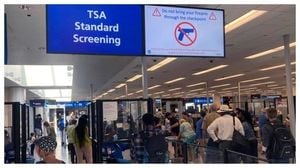In an era where public engagement is increasingly recognized as a cornerstone of effective governance, local authorities across the United Kingdom and the United States are ramping up efforts to listen to their communities. Two recent initiatives—Monmouthshire County Council’s resident survey in Wales and the Iowa Department of Transportation’s revamped public feedback portal in the U.S.—highlight a growing trend: putting residents’ voices at the heart of decision-making.
Monmouthshire County Council, nestled in the scenic southeast of Wales, has just launched its second annual resident survey, inviting locals to weigh in on everything from education and social care to recycling and leisure centers. The survey, open until October 31, 2025, is an open invitation for every Monmouthshire resident to share their experiences and opinions. It’s not just a tick-box exercise; the council’s Cabinet Member for Equalities and Engagement, Councillor Angela Sandles, made that clear when she stated, “We want to hear your thoughts on living in Monmouthshire, your experiences in your local area, your opinions on the council’s services, and your involvement in your local community.” According to Monmouthshire County Council, this initiative is part of an ongoing commitment to truly understand what matters to residents.
For those who want to see what last year’s survey revealed, the 2024 results are available online at the council’s website. This transparency, combined with the council’s willingness to ask again in 2025, signals a shift in how local government interacts with its citizens—less top-down, more collaborative. The survey is hosted by Data Cymru, as part of their National Resident Survey, providing a framework that supports local councils in understanding both performance and perception. Participation is made easy: residents can fill out the survey online at Let’s Talk Monmouthshire or pick up a paper copy at community hubs and leisure centers, ensuring accessibility for all.
Across the Atlantic, the Iowa Department of Transportation (DOT) has been busy updating its own approach to public feedback. In 2025, the department rolled out a new web-based portal at PublicInput.com, designed to make it easier than ever for Iowans to share their thoughts on road and bridge projects. The move comes as part of a broader effort to modernize how the DOT collects and processes feedback, ensuring that every voice—whether left via voicemail, email, or an online form—is heard and considered.
Trisha Miller, spokesperson for the Iowa DOT, explained the improvements: “This one is a more comprehensive so the voicemail, e-mail and electronic comments. From the website are all gathered and stored on a project basis.” In practical terms, that means all feedback for a particular project—say, a new bypass or bridge replacement—is collected in one place, making it easier for decision-makers to spot trends and respond to concerns. Residents receive notices about projects, each containing a link to the feedback portal. As Miller described, “And it says, ‘not able to attend in the open house, learn about the project and share your feedback online.’ And if you click that link it will take you to the public input.”
The portal doesn’t just collect comments; it also provides detailed project overviews and event schedules. “It shows you the project overview and shows you all of the events and then you’re able to see the comment link and submit your comments there as well,” Miller said. This transparency is designed to foster trust and encourage more residents to participate, even if they can’t make it to in-person events.
Feedback varies widely from community to community, Miller noted, but the department sees a steady stream of input across its six districts. “It varies widely between communities, but we get a consistent and. We get consistent feedback through all the projects that we do throughout the state. I think the least amount of comments we get are bridge replacement,” she observed. That’s perhaps no surprise—roads that disrupt daily commutes tend to spark more public interest than a bridge quietly being replaced out of sight.
The Iowa DOT doesn’t rely solely on its online portal. Traditional methods like open houses and public hearings remain part of the process, especially during key stages of project development. These events offer residents a chance to ask questions, learn about detours and right-of-way issues, and voice their concerns face-to-face with project managers. According to the Iowa DOT, combining digital convenience with in-person engagement ensures that no group is left out—whether they’re tech-savvy or prefer a more personal touch.
Both Monmouthshire and Iowa’s efforts reflect a broader shift in public administration. Gone are the days when decisions about local services or infrastructure were made behind closed doors, with little input from those directly affected. Today, councils and departments recognize that meaningful feedback leads to better outcomes—whether that’s a smoother bus route, a more accessible library, or a road project that genuinely reflects local needs.
It’s not just about collecting data, though. The real challenge is turning that feedback into action. For Monmouthshire, the insights from last year’s survey informed a range of service improvements and policy tweaks, demonstrating that residents’ opinions can drive real change. In Iowa, the DOT uses feedback to adjust project timelines, improve communication about detours, and even reconsider aspects of design when warranted.
Accessibility is a recurring theme in both initiatives. Monmouthshire’s dual approach—offering both digital and paper surveys—ensures that older residents or those without internet access aren’t left out. Similarly, Iowa’s portal is designed to be user-friendly, while public hearings and open houses provide alternative avenues for engagement. This inclusive approach is key to gathering a truly representative picture of community sentiment.
There’s also a sense of accountability woven into both programs. By publishing survey results and project updates online, councils and departments invite scrutiny—and, hopefully, trust. Residents can see how their input is used, fostering a sense of ownership over local decisions. As Miller pointed out, the portal’s project-based organization means feedback doesn’t just disappear into a black hole; it’s tied directly to the issues people care about.
Of course, challenges remain. Not everyone takes the time to fill out a survey or submit a comment, and some voices are inevitably louder than others. Ensuring that feedback is weighed fairly—and that minority opinions aren’t drowned out by the majority—requires diligence and a genuine commitment to listening. But as these initiatives show, the tools for meaningful engagement are more robust than ever.
As the October 31 deadline for Monmouthshire’s survey approaches, and as Iowa’s DOT continues to roll out its updated portal, one thing is clear: the era of passive governance is fading. Local authorities are opening their doors (and their inboxes) to the people they serve, recognizing that good decisions start with good conversations. For residents on both sides of the Atlantic, the message is simple: your voice matters—so speak up.




